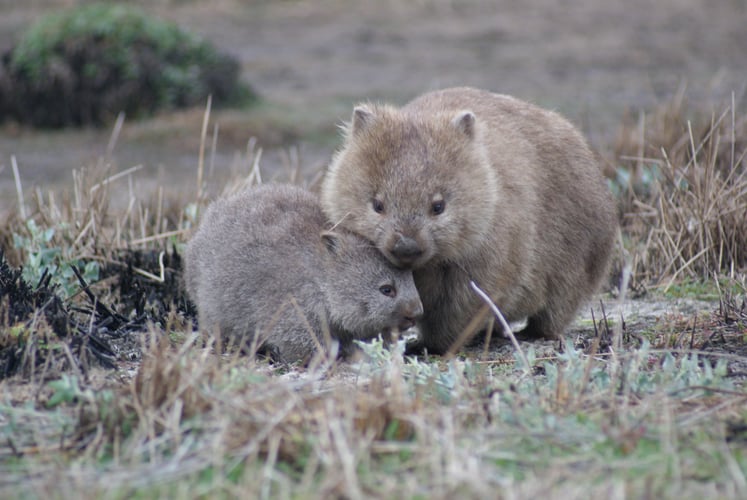Wombats
Wombats are natural digging machines and perform a very important role in our ecosystem. Wombats can dramatically improve soil health by bringing important nutrients to the surface and help organic matter and plant seedling mix into compacted soil through their burrowing actions.
Wombat burrows also provide shelter for many other native species and protection from non-native predators.
But sadly, wombats are disappearing.
The fatal combination of disease, increasing habitat loss, road deaths and extreme weather events are all serious threats to the future of our precious wombats.
- The Northern Hairy-nosed wombat is listed as Critically Endangered under the International Union for the Conservation of Nature (IUCN) Redlist of Threatened Species and is presumed extinct in NSW
- The Southern Hairy-nosed wombat is listed as Near Threatened by the IUCN as is listed as Endangered in NSW
- The Bare-nosed wombat, known as the Common wombat, is becoming mush less common with increasingly smaller ranges

Appearance
Most wombats seen in NSW will be the Bare-nosed wombat.
They have a large nose covered, small eyes and a tiny tail which is usually hidden by fur.
Their fur can range in colour from dark brown to red. They have a hard rump, made up of mainly cartilage which helps them to excavate and defend their burrows.
Wombats can grow up to around 1.3 metres in length and weight up to 36 kilograms.
Behaviour
Wombats live in burrows that can be up to 30 metres long. The different species of wombats have different burrow designs, but all share their burrows with other wombats.
Wombats usually stay in their burrows during the day and come out at night to feed. They are very territorial with their feeding grounds and will travel up to 3kms per night looking for food.
Wombats can run as fast as 40km/h.
Breeding
Wombats can reproduce after they reach 2 years of age and they normally breed between September and December. Wombats are marsupial mammals and the newborn wombat, which weighs about 1 gram and is less than 3 centimetres long, has to crawl from the birth canal into the mother's pouch. The pouch faces backwards, which protects the joey while the mother is digging. Young wombats will normally stay in the pouch for 7-10 months.

Mange
Wombat mange is a life-threatening disease caused by the parasitic mite, Sarcoptes scabiei. The mite burrows into the skin of its host causing thick plaques, resulting in hair loss and open wounds.
In many cases, when caught early enough, wombats with mange can be successfully treated.
You can read more about mange on our brochure or join our Community Mange Treatment Program to help treat wombats in your local area.

Wombat Rescue
Please do not approach any injured adult wombats.
If you suspect the wombat is suffering from mange, take note of its exact location and where on the body is affected.
Please call WIRES Rescue Office 1300 094 737 or submit our Report a Rescue form below.
If you have found a female wombat that has recently been killed, perhaps hit by a car, please check for joeys. Please check inside the pouch and also in the surrounding area as the joey could have been bumped out of the pouch, or it may be hiding in nearby bushes.
If you find the joey, please keep it in a warm, dark, quiet place e.g. wrapped in a towel or sheet in a ventilated carrier and call WIRES Rescue Office 1300 094 737 or submit our Report a Rescue form below.
As the joey will need immediate care you can also transport it directly to your nearest vet, please still contact WIRES to let us know which vet you are going to.
WIRES would like to acknowledge our partner Bravecto for their ongoing support and dedication to wombat conservation.

Report a Rescue
For wildlife rescue assistance you must call 1300 094 737 or fill in the Report a Rescue form. All other forms of contact including Facebook are not monitored for rescues.